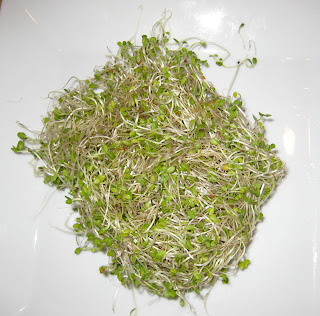To be more specific, Secret 26 limits itself to the Asian mushrooms: shiitake, maitake and reishi. However, when I went to the local grocery store, the only mushrooms I could easily find were white mushrooms, Portobello mushrooms and crimini mushrooms. Of the three Asian mushrooms lauded by Beare, I was finally able to locate shiitake in both fresh and dry versions. When I looked at the 'fresh' dried-out shiitake in dismay, an observant Russian lady shopper winked at me and stated: "Honey, the dried-looking ones are better, they weigh less so cost less and you only need to soak them in water to plump them up again!"
 |
| Shiitake: available in your grocery store and under oak logs |
So, according to Beare, what are the benefits of eating these three Asian mushrooms? I will first list the advantages of shiitake, reishi and maitake mushrooms, then research whether more easily obtainable mushrooms have benefits, too.
Shiitake (Japanese) or 'oak mushroom'
- contains immune boosting polysaccharide lentinan. In Japan lentinan is used as a powerful anti-tumor medicine as it helps white blood cells remove cancer cells
- is used to treat coughs
- reduces cholesterol levels
- contains over 840 IU/100 grams of anti-carcinogenic Vit. D
Reishi (Chinese) or 'plant of immortality"
- improves immunity
- strengthens our cardiovascular system
- helps treat asthma, arthritis and liver disorders by enhancing the concentration of T-helper cells
- is anti-allergenic, anti-inflammatory, anti-bacterial and anti-viral
- has antioxidant characteristics
 |
| Reishi or 'the Elixir of Life' |
Maitake (Japanese) or 'dancing mushroom'
- contains immune-system enhancing polysaccharide beta-glucan
- contains D-fraction, which boosts our natural killer cells. D-fraction has been shown to slow down the growth of tumors in mice
- D-fraction also reduces the unpleasant side-effects of chemotherapy
- contains SX-fraction, which helps maintain healthy blood sugar levels
- SX-fraction also seems to be beneficial in lowering blood pressure
- SX-fraction assists in treating stomach conditions
 |
| Maitake, the dancing mushroom that makes mushroom hunters 'dance for joy' when it is found |
More commonly found on supermarket shelves in U.S. grocery stores in Colorado than these Asian mushrooms are white mushrooms, Portobello mushrooms and Crimini mushrooms. Are these really three different kinds of mushroom, or one and the same?
White mushrooms or Agaricus bisporus have many names and are also known as crimini, button, champignon, common, table, Roman/Swiss/Italian brown and grow up to become Portobellos. So how does this one mushroom compare to its more exotic Asian cousins?
White mushroom
- contains minerals such as sodium, potassium, phosphorus
- contains Vit. D
- may inhibit aromatase, which in turn may lower estrogen levels
- apparently women who consume white mushrooms on a regular basis have a lower incidence of breast cancer
- if you eat fresh white mushrooms daily and drink green tea, the risk for breast cancer drops by more than 80% 1
- enhances your immune systems, in particular the function of the dendritic cells. Dendritic cells are antigen presenting cells
Note:
- Raw white mushrooms contain trace amounts of carcinogenic hydrazine derivatives such as agaritine and gyromitrin. You may wish to cook white mushrooms before consuming them as heat inactivates these derivatives.
- You can purchase shiitake logs and grow these mushrooms yourself if you prefer freshly harvested mushrooms.
Personal observation:
- since I associate the color white in food such as white sugar, white flour, white rice with a lack of nutrients, I erroneously assumed that white mushrooms are equally deficient in nutrients. However, the former are processed and the latter grow. As the blog shows, even white mushrooms are beneficial.
- I have noticed that consuming Portobello mushrooms cooked in olive oil for dinner greatly enhances sleep. If you have difficulties falling asleep, eat one large cooked Portobello mushroom before going to bed.
Bottom line: if shiitake, maitake and reishi are not easily obtainable, enjoy cooked white /crimini /Portobello mushrooms instead!










